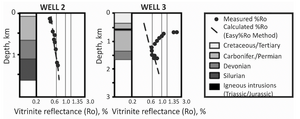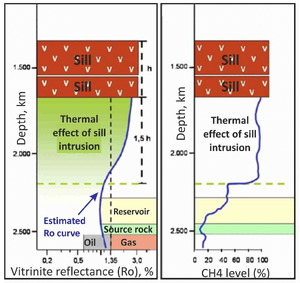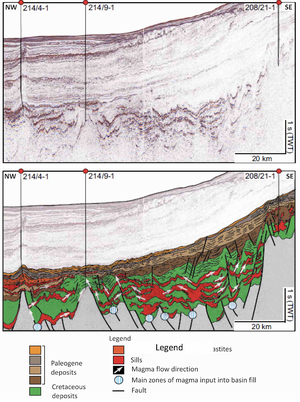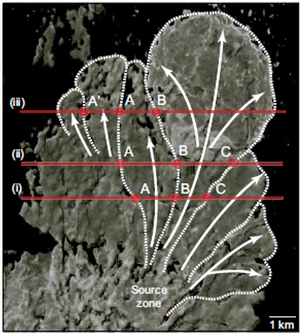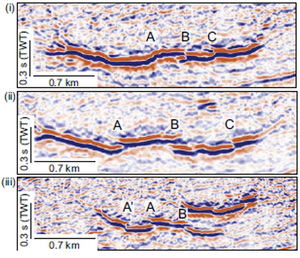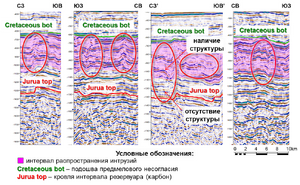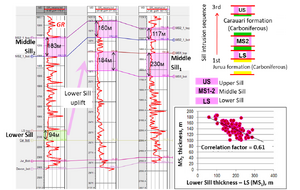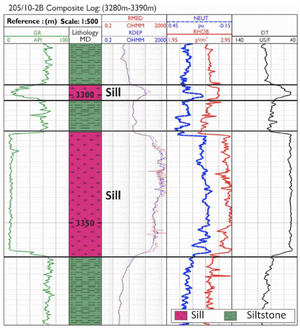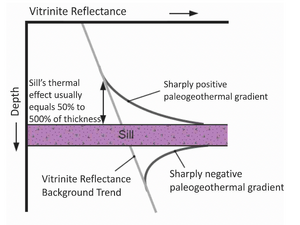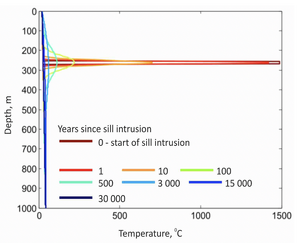Sill intrusion mechanism, parameters, and temperature effect of sills on a petroleum system
| Wiki Write-Off Entry | |
|---|---|

| |
| Author | Anastasiya Polishchuk |
| Affiliation | Tyumen Petroleum Research Center |
| Competition | 2021 Middle East Wiki Write Off |
The oil and gas content of basins in which embedded magmatic bodies (sills) are present in the host rock has been demonstrated in the Siberian Platform, South America (Amazonas, Solimões, and Paraná Basins), Africa (the Karoo Province), Australia (the Ceduna shelf sub-basin), etc. . Such petroleum systems are classified as atypical petroleum systems.
A petroleum system is considered atypical if the source rock maturity is not directly related to the subsidence of the sedimentary cover / host rock .
Many Russian and Western geologists have made significant contributions to the understanding of atypical petroleum systems. Methodological approaches to assessing the resource potential of a basin with an atypical petroleum systems differ and the influence and role of sills on host rocks remains controversial. ). Depending on the approach selected, the processes of hydrocarbon generation, migration and accumulation can differ significantly.
Catagenetic zones in atypical systems differ significantly from those of ordinary basins due to the intense effect of sills on their host sediments. This, in turn, has led to differences in methodological approaches for assessing the resource potential of an atypical petroleum systems also differ.
Overview of Sills
A sill is a sheet-like intrusive body deposited in horizontal or slightly dislocated rock strata . The formation of sills occurs when the hydrostatic pressure of magma exceeds rock pressure and the tensile strength of rocks , . Crosscutting bodies, such as dikes/dike swarms, feed the sills. Lower effective stress allows magma to propagate laterally until the overlying stratum is fractured due to excess pore pressure and a stress release occurs. The newly-formed/existing fractures may serve as pathways for the melt to ascend to higher stratigraphic levels. The final phase of sill formation is accompanied by repeated injection of magma and lateral expansion into the overlying stratigraphic levels, where the magma head exceeds the pressure of the overlying rock stratum.
Figure 1 demonstrates catagenesis in the Amazonas Basin (Brazil) based on well data. The heating of the sediment is directly controlled by the depth of immersion, deep heat flow (Well 2) and the development of sills (Well 3).
Figure 2 shows a case study in the Solimoes Basin (Brazil). The distance between the bottom of the sill and the top of the zone containing dry gas is roughly equal to 150% of the thickness of the sill. Directly below the dry gas are gas condensate and light oil.
Thus, an evaluation of atypical petroleum systems should include not only the aforementioned factors, but also an in-depth analysis of the sill complex and the processes associated with their intrusion.
Evaluation of Atypical Petroleum Systems Containing Sills
In evaluating basins with sills, factors indicating the degree the generating strata was heated and the phase composition of hydrocarbons in traps are critical. The following characteristics should be studied and assessed.
Timing, Sequence and Direction of Sill Intrusions
This information can be determined by using the following approaches and methods: • Radioactive Dating K/Ar, Ar/Ar, Rb/Sr methods , , : According to the isotope analysis, a peak of magmatic activity in the Solimoes Basin was determined to have occurred 200 million years ago (Penatecaua magmatism) . As a result, source rock deposits were subjected to conditions conducive for oil and deep gas formation zones leading to hydrocarbons being accumulated in structural traps existing at the time. • Mapping with Seismic Data Geometry and connectivity of sill complexes, feeding channels/dikes can be determined based on seismic data , . Analysis of data from various trap provinces shows a wide variety of sill forms , . This analysis is possible given that sills’ elastic and electrical properties differ markedly from the host rock bodies in seismic data. Sills demonstrate higher velocities of compressional waves (Vp ~5-7 km/s) compared to the sedimentary cover rocks (Vp ~3-5 km/s) . 3D mapping of sills makes it possible to take a fresh look at the mechanisms of their formation and distribution. An analysis of case studies on the shelf of Norway, Australia, and Great Britain shows that the underlying saucer-shaped sills fed overlying ones by transporting magmatic melt through connecting channels and existing faults , , . For example, during analysis of trap complexes in the Parana Basin (Brazil), vertical series of saucer-shaped sills and their feeding faults and dikes were revealed through 2D seismic data or more specifically by using seismic attributes (RMS, tecVA) and picking out the maximum and minimum seismic readings .
Additionally, sill geometry from the volcanic basins in the Atlantic Ocean has been mapped based on 3D seismic data , . The basis for this work was the difference in acoustic stiffness of host rocks versus intrusive sills which are marked by high acoustic impedance values (Figure 3-5).
• Sill thickness analysis based on seismic and well data
In order to determine the sequence of sill intrusions within the Solimoes Basin (Brazil), A.V. Polishchuk et al. conducted a case study on the Jurua Subbasin seismic time sections and sill thickness were analyzed.
Above the sills, the rock strata is uplifted thereby creating a more complex structure in the formations overlying the sills (Figure 6). A.V. Polishchuk et al have built a significant inverse correlation between the thicknesses of the Lower and Middle Sills. These findings led to the conclusion that the sills were introduced upward. The Lower Sill was the first to intrude. In the overlying sediments, it led to the formation of positive and negative structures corresponding to its thinner and thicker zones. These structures affected the thickness of the Middle Sill, which was the second to intrude. In the positive structures above the Lower Sill, the Middle Sill is thinner; but in the negative structures, it is thicker. In general, sills cool down rather quickly, therefore, their thicknesses are usually controlled only by the geological setting at the time of intrusion (Figure 7).
• Flow direction of paleo magma The direction of magma flows can be determined by analyzing magnetic susceptibility in combination with a macroscopic description of the sills (orientation of minerals, frozen gas bubbles, plume structures/fractures in the edge zones of dikes) . • Petrographic descriptions Petrographic descriptions demonstrate the various chemical compositions of sills relating to various intrusion phases . High-temperature minerals predominate at the early stages of sill formation, but are gradually replaced upward by low-temperatures minerals. A case study of trace element distribution in traps in the southern section of the Siberian Platform provides examples of high concentrations of Cr and Ni in first-intrusion-phase sills which prevail in olivine and pyroxene. In the traps of later intrusion phases, the concentration of Cr/Ni decreases and the amount of Ba and Sr composing plagioclases increases . • Aerial photographs, Field Descriptions of Outcrops & Regional Stress Direction In the works of Stephens T. L and Walker R.J. a qualitative analysis of the influence of the stress magnitude and direction on the distribution of dikes and sills is made. Mohr's circles cited in these papers are borrowed from the classics materials on resistance which consider low-rate elastic deformations of homogeneous materials under load. Applying Mohr's circles to describe the behavior of rocks allows us to form only a qualitative picture of the action of normal and tangential stresses , . To obtain a more accurate description of the deformation and destruction of existing rock, the creep theory and strength calculations of composite layered materials should be used while taking into account the heterogeneity of elastic, strength, and other properties of rocks.
Thermodynamic and Fluid Properties of Magma
C.E. Lesher and F.J. Spera stated that silicate-rich magmas (50-70%) composition are the most movable as well as the most common in the world . A large amount of volatile components (H2S, N2, HCl, HF, COS, and SO2) contribute to increased viscosity. The temperature and pressure determine the rheological and dynamic properties of magma. According to G.D. Feoktistov, the speed of the melt is determined by its excess hydrostatic pressure and viscosity, size of the supply channel and the sill chamber . The temperature and viscosity of the melt are also influenced by the interaction of magma with the surrounding rocks, their melting, and the formation of new phases. If low-melting eutectics are formed, the hardening temperature and melt viscosity decrease.
The thermal effect of the magma flow regime on the surrounding rocks should be considered. In a turbulent flow, the heat transfer at the boundary with the host rock is greater than in laminar flow. In turbulent flows, the speed of cooling along the interface with the host rock is slower and therefore the magma channel narrows more slowly. As a result, a sill might intrude to a greater distance due to the lower hydraulic resistivity of the flow. A slower flow will lead to magma cooling along the contact with hard host rocks resulting in a layer of solidified magma
Sill Thickness
Sill thickness is determined by correlating well logging data from wells that penetrated the sill complexes (low GR readings, high resistivity, and high P-wave velocities and densities) (Figure 8) .
Distance Between Nearest Sill and Source Rock
The distance between the nearest sill and the source rock indicates how intense the generating strata was heated, as well as the hydrocarbon phase composition in the traps. The heat from the sill will induce a thermal aureole whose thickness will vary between 50% to 500% of the sill thickness. [3], [10] (Figure 9) , . The main influence of a sill on the regional thermal field occurs one million years after the moment of its intrusion into the host rock. The resulting change in heat flux can reach 5-25 mW/m2 . The thermal anomaly from a sill that is a few kilometers thick disappears after 5-15 million years , while the effect from sills up to 20 m thick disappear after 15,000 years (Figure 10).
Subsidence History of the Host Rock
There has been much research regarding the influence of magmatic melt on the host rock structure (for examples see bibliography references 1, 27 and 29). One school believes that no uplift of sedimentary cover occurs when sills are formed and that magma fills horizontal fractures formed as a result of subsidence and compaction of the rock blocks (V.S. Staroseltsev, V.M. Lebedev, F.Yu. Levinson-Lessing, M.G. Ravich, L.A. Chaika, P.E. Offman, etc.). Another school, on the contrary, argues that when sills are introduced, they raise the host sediments up to a thickness equal to the sill thickness (Yu.K. Dzevanovsky, A.P. Lebedev, V.I. Gonshakova, N.V. Melnikov, A.V. Tarasov, etc).
A. Du Toit, while describing the dolerites intrusion process in the Karoo Province [5], assumed a downward layer-by-layer injection mechanism. Upon intrusion of an additional volume of magma, the thick igneous strata of basaltic lava of the Stormberg group and the underlying metamorphosed shale layers exerted pressure on the underlying strata that significantly exceeded the pressure of the magmatic melt. As a result, the magma, having reached the upper horizons, spread from top to bottom. A.V. Tarasov (31) has a different opinion, stating that sills actively affect the host rocks pushing them out “like a piston”. A similar mechanism was described by G.K. Gilbert (9) who analyzed the mechanism of laccoliths intrusion in the Rocky Mountains of North America (Utah): the laccoliths intrusion led to the formation of dome-shaped structures. Hence, the published literature has no unambiguous answer to the issue of the sills’ effect on the geometry of petroleum basin host rocks.
Summary
In basins with atypical petroleum systems, the intrusion of sheet-like and crosscutting sills significantly affects the processes of generation, migration, and accumulation of hydrocarbons. The distance between the bottom of the sill and the top of the source rock stratum is one of the key factors in determining the phase composition of hydrocarbon accumulations in the traps. Therefore, the main group of methodological issues related to modeling a petroleum system of such basins is formed by the following sill-related issues: - Trap magmatism mechanisms and impact on a petroleum system; - Propagation of sills within the host rock; - Sequence of sills intrusion into the host rock.
Acknowledgments
The author is grateful to Sidnei Rostirolla, PhD, for help and advice on the geological structure of the Solimões Basin (Brazil). The author is especially grateful to Mikhail V. Lebedev, PhD, for advice and support in this research effort.
References
K. Senger, 2017; H. Svensen, 2017; C. Magee, 2016; G. D. Feoktistov, 1972).
Magoon, L.B., 1994. The petroleum system / L.B. Magoon, W.G. Dow // AAPG Memoir 60, p. 3-23.
V.L. Masaitis, 1967; G. D. Feoktistov, 1978, 1972; D. M. Turovtsev, 1970, A. E. Kontorovich, A. V. Khomenko, 2001; O. O. Abrosimova, 2009; K. Thomson, N. Schofield, 2008; I. Aarnes, 2011; K. Senger, 2013 and others.
F.Yu. Levinson-Lessing, 1932; V.S. Staroseltsev, 1975, 1989; A.V. Migursky, 1986, 1989, 1997.
I.I. Nesterov, 1988. Methodology for assessing the oil and gas content of local traps / I.I. Nesterov [et al.], Moscow: Nedra PH, 196 p.
V.L. Masaytis, 1967. Form and mechanism of trap intrusions and extrusions formation on the Siberian Platform / Materials on geology and mineral resources of East Siberia, Nedra PH, 171 p.
G. Einsele, 1982. Mechanism of sill intrusion into soft sediment and expulsion of pore water. / G. Einsele // Geologisches Institut Universitat Tubingen, Germany. p. 1169-1175.
M. Silv, 2015. Analysis of the hydrocarbon maturation windows of the Amazon basin // M. Silva, Mohriak, W. Holanda et al // Fourteen International Congress of the Brazilian Geophysical Society, p. 1-6.
G.D. Feoktistov, 1978. Petrology and conditions for the trapp sills formation / G.D. Feoktistov, Science, Sib. department, 166 p.
J.R.W. Filho, 2006. O diabasio nas bacias paleozoicas amazonicas heroi ou vilao? / J.R.W. Filho, W.A.S. Travassos, D.B. Alves // B. Geoci. Petrobras, Rio de Janeiro, v.14, n.1, p. 180-181.
S. Naviset, 2017. Sill emplacement during rifting and inversion from three-dimensional seismic and well data, Phitsanulok basin, Thailand / S. Naviset, C. K. Morley, D. H. Naghadeh, J. Ghosh // Geosphere, v.13, no.6, p. 2017-2040.
C.F. Barata, Caputo, M.V., 2007. Geologia do petroleo da bacia do Solimoes, O “estado da arte”, PDPETRO, No.4, p. 1-10.
C. Magee, 2016. Lateral magma flow in mafic sill complexes / C. Magee, J.D. Muirhead, A. Karvelas, et. al // Geosphere, vol.12 no 3, p. 809-841.
S. Naviset, p. 2017-2040.
K. Senger, 2013. Geometries of doleritic intrusions in central Spitsbergen, Svalbard: an integrated study of an onshore-offshore magmatic province with implications for CO2 sequestration / K. Senger, S. Roy, A. Braathen et al. // Norwegian journal of geology, vol.93, p. 143-166.
C. Magee, p. 809-841.
E.R. Neuman, 2003. Emplacement mechanism and magma flows in sheet intrusions in sedimentary basins / E.R. Neuman, S. Planke, A. Malthe-Sorenssen // Sill emplacement – NFR, VBR report, p. 1-10.
S.P. Holford, 2013. Impacts of igneous intrusions on source and reservoir potential in prospective sedimentary basins along the western Australian continental margin / S.P. Holford, N. Schofield, C.A-L. Jackson, C. Magee, P.F. Green, I.R. Duddy // Igneous intrusions in prospective sedimentary basins, p. 1-27.
K. Thomson, 2008. Lithological and structural controls on the emplacement and morphology of sills in sedimentary basins / K. Thomson, N. Schofield // Geological society, London, special publications, v.302, p. 31-44.
N. Shofiel, 2013. Development of intra-basaltic lava field drainage systems within the Faroe-Shetland basin / N. Shofield, D.W. Jolley // Petroleum Geoscience, p. 1-16.
D.F.B. Costa, W.H.S. Santos, 2016. Bergamaschi Analysis of the geometry of diabase sills of the Serra Geral magmatism, by 2D seismic interpretation, in Guarei region, Sao Paulo, Parana Basin, Brazil / D.F.B. Costa, W.H. Santos, S. Bergamaschi, E. Pareira // Brazil Jiurnal of geology, 46 (4), p. 606-615.
K. Thomson, 2008. Lithological and structural controls on the emplacement and morphology of sills in sedimentary basins / K. Thomson, N. Schofield // Geological society, London, special publications, v.302, p. 31-44.
C.A. Schofield, Jackson L., Magee C., P.F. Green, I.R. Duddy I.R., 2013. Igneous intrusions in prospective sedimentary basins, p. 1-27.
A.V. Polischuk, 2018. Modeling a petroleum system with trap magmatism / A.V. Polischuk, M.V. Lebedev, A.N. Perepelina // Oil Industry. No. 1. p. 12-17. (Note: Polischuk’s surname is officially spelled Polishchuk.)
G.M. Airoldi, Flow dynamics in mid-Jurassic dikes and sills of the Ferrar large igneous province and implications for long-distance magma transport / G. M. Airoldi, J. D. Muirhead, S. M. Long, E. Zanella, J. D. L. White // Tectonophysics 683, 2016. – pp. 182-199.
V.A. Lebedev, 2016. Age of young sills of the Tsan complex (Greater Caucasus) and isotope-geochemical evidence of the hybrid origin of their magmas / V. A. Lebedev, O.Z. Daduri, M.G. Togonidze, Yu.V. Goltsman // Petrology, Vol. 24, No. 4, p. 339-362.
G.D. Feoktistov, 1978. Petrology and conditions for the trap sills formation / G.D. Feoktistov, Science, Sib. department, 166 p.
T.L. Stephens, 2017. Igneous sills record far-field and near filed stress interactions during volcano construction: Isle of Mull, Scotland / T. L. Stephens, R. J. Walker, D. Healy, A. Bubeck, R. W. England, K.J.W. McCaffrey // Earth and planetary science letters, 478, p. 159-174.
R.J. Walker, 2017. Igneous sills as a record of horizontal shortening: the San Rafael Sub-Volcanic field, Utah / R. J. Walker, D. Healy, T.M. Kawanzaruwa, K. A. Wright, R.W. England, K.J.W. McCaffrey et. al // GSA Bulletin, 129 (9-10), p. 1052-1070.
C. E. Lesher, 2015. Thermodynamics and Transport Properties of Silicate Melts and Magma / C.E. Lesher, F.J. Spera // The encyclopedia of Volcanoes, second edition, p. 113-141.
G.D. Feoktistov, 166 p.
N.J. Mark, 2018. Igneous intrusions in the Faroe Shetland basin and their implications for hydrocarbon exploration; new insights from well and seismic data / N. J. Mark, N. Schofield, S. Pugliese et al // Marine and Petroleum Geology, vol. 92, p. 733-753.
C.F. Barata, p 1-10.
S.P. Holford, p. 1-27.
T. Xiao-Yin, 2014. Modeling of thermal effects of igneous intrusions on the temperature field and organic maturity in the changchang sag, Qiongdongnan basin, South China Sea // T. Xiao- Yin, Z. Gong-Cheng, L. Jian-She, Y. Shu-Chun, R. Song, H. Sheng-Biao // Chinese journal of geophysics, vol.57, no.2, p. 219-229.
A.E. Kontorovich, 2001. Theoretical foundations of estimating the oil and gas content of sedimentary basins with intense trap magmatism / A.E. Kontorovich, A.V. Khomenko, Geology and Geophysics Jrnl, Vol. 42, No. 11-12, p. 1764-1773.
Peace, A., 2015. Quantifying the influence of sill intrusion on the thermal evolution of organic-rich sedimentary rocks in non-volcanic passive margins: an example from ODP 210-1276, offshore Newfoundland, Canada / A. Peace, K. McCaffrey, J. Imber, R. Hobbs, J. Hunen, K. Gerdes // Basin Research, p. 1-17.
Bibliography
1. Abrosimova, O.O., 2009. Structural features of the Cambrian complex within the Mirninsky Ledge (Nepsko-Botuobinsky Anteclise) / O.O. Abrosimova, S.I. Kulagin, Petroleum Geology Jrnl, p. 48-52.
2. Airoldi, G. M., 2016. Flow dynamics in mid-Jurassic dikes and sills of the Ferrar large igneous province and implications for long-distance magma transport / G. M. Airoldi, J. D. Muirhead, S. M. Long, E. Zanella, J. D. L. White // Tectonophysics 683, p. 182-199.
3. Barata, C.F., Caputo, M.V., 2007. Geologia do petroleo da bacia do Solimoes, O “estado da arte”, PDPETRO, No.4, p. 1-10.
4. Costa, D.F.B., Santos, W.H., S., 2016. Bergamaschi Analysis of the geometry of diabase sills of the Serra Geral magmatism, by 2D seismic interpretation, in Guarei region, Sao Paulo, Parana Basin, Brazil / D.F.B. Costa, W.H. Santos, S. Bergamaschi, E. Pareira // Brazil Jiurnal of geology, 46 (4), p. 606-615.
5. Du Toit, A.I., 1920. The Karoo dolerite of South Africa: a study of hypabyssal injection / A.I. Du Toit // Transactions Geological Society of South Africa, 23. p. 1-42.
6. Einsele, G., 1982. Mechanism of sill intrusion into soft sediment and expulsion of pore water. / G. Einsele // Geologisches Institut Universitat Tubingen, Germany. p. 1169-1175.
7. Feoktistov, G.D., 1978. Petrology and conditions for the trapp sills formation / G.D. Feoktistov, Science, Sib. department, 166 p.
8. Filho, J.R.W., 2006. O diabasio nas bacias paleozoicas amazonicas heroi ou vilao? / J.R.W. Filho, W.A.S. Travassos, D.B. Alves // B. Geoci. Petrobras, Rio de Janeiro, v.14, n.1, p. 180-181.
9. Gilbert, G.K., 1877. Report on the geology of the Henry Mountains / G.K. Gilbert // U.S. Geographical and Geological Survey of the Rocky Mountains Region, 160 p.
10. Holford, S.P., 2013. Impacts of igneous intrusions on source and reservoir potential in prospective sedimentary basins along the western Australian continental margin / S.P. Holford, N. Schofield, C.A-L. Jackson, C. Magee, P.F. Green, I.R. Duddy // Igneous intrusions in prospective sedimentary basins, p. 1-27.
11. Kontorovich, A.E., 2001. Theoretical foundations of estimating the oil and gas content of sedimentary basins with intense trap magmatism / A.E. Kontorovich, A.V. Khomenko, Geology and Geophysics Jrnl, Vol. 42, No. 11-12, p. 1764-1773.
12. Kurchikov, A.R., 1992. Hydrogeothermal criteria of oil and gas content / A.R. Kurchikov // Ministry of Geology. G 46 USSR; West-Sib. R&D. Geological Exploration. Oil Institute, Moscow: Nedra PH, 231 p.
13. Lebedev, V.A., 2016. Age of young sills of the Tsan complex (Greater Caucasus) and isotope-geochemical evidence of the hybrid origin of their magmas / V. A. Lebedev, O.Z. Daduri, M.G. Togonidze, Yu.V. Goltsman // Petrology, Vol. 24, No. 4, p. 339-362.
14. Lesher, C.E., 2015. Thermodynamics and Transport Properties of Silicate Melts and Magma / C.E. Lesher, F.J. Spera // The encyclopedia of Volcanoes, second edition, p. 113-141.
15. Magee, C., 2016. Lateral magma flow in mafic sill complexes / C. Magee, J.D. Muirhead, A. Karvelas, et. al // Geosphere, vol.12 no 3, p. 809-841.
16. Magoon, L.B., 1994. The petroleum system / L.B. Magoon, W.G. Dow // AAPG Memoir 60, p. 3-23.
17. Masaytis, V.L., 1967. Form and mechanism of trap intrusions and extrusions formation on the Siberian Platform / Materials on geology and mineral resources of East Siberia, Nedra PH, 171 p.
18. Mark, N.J., 2018. Igneous intrusions in the Faroe Shetland basin and their implications for hydrocarbon exploration; new insights from well and seismic data / N. J. Mark, N. Schofield, S. Pugliese et al // Marine and Petroleum Geology, vol. 92, p. 733-753.
19. Naviset, S., 2017. Sill emplacement during rifting and inversion from three-dimensional seismic and well data, Phitsanulok basin, Thailand / S. Naviset, C. K. Morley, D. H. Naghadeh, J. Ghosh // Geosphere, v.13, no.6, p. 2017-2040.
20. Nesterov, I.I., 1988. Methodology for assessing the oil and gas content of local traps / I.I. Nesterov [et al.], Moscow: Nedra PH, 196 p.
21. Neuman, E.R., 2003. Emplacement mechanism and magma flows in sheet intrusions in sedimentary basins / E.R. Neuman, S. Planke, A. Malthe-Sorenssen // Sill emplacement – NFR, VBR report, p. 1-10.
22. Peace, A., 2015. Quantifying the influence of sill intrusion on the thermal evolution of organic-rich sedimentary rocks in non-volcanic passive margins: an example from ODP 210-1276, offshore Newfoundland, Canada / A. Peace, K. McCaffrey, J. Imber, R. Hobbs, J. Hunen, K. Gerdes // Basin Research, p. 1-17.
23. Polischuk, A.V., 2018. Modeling a petroleum system with trap magmatism / A.V. Polischuk, M.V. Lebedev, A.N. Perepelina // Oil Industry. No. 1. p. 12-17. (Note: Polischuk’s surname is officially spelled Polishchuk.)
24. Schofield, C.A-L. Jackson, C. Magee, P.F. Green, I.R. Duddy, 2013. Igneous intrusions in prospective sedimentary basins, p. 1-27.
25. Senger, K., 2013. Geometries of doleritic intrusions in central Spitsbergen, Svalbard: an integrated study of an onshore-offshore magmatic province with implications for CO2 sequestration / K. Senger, S. Roy, A. Braathen et al. // Norwegian journal of geology, vol.93, p. 143-166.
26. Shofield, N., 2013. Development of intra-basaltic lava field drainage systems within the Faroe-Shetland basin / N. Shofield, D.W. Jolley // Petroleum Geoscience, p. 1-16.
27. Staroseltsev, V.S., 1975. Interrelation of intrusive magmatism with the tectonics of the Tunguska syneclise / V.S. Staroseltsev, V.M. Lebedev // Proceedings of SNIIGIMS, Issue 217, p. 100-108.
28. Silva, M., 2015. Analysis of the hydrocarbon maturation windows of the Amazon basin // M. Silva, Mohriak, W. Holanda et al // Fourteen International Congress of the Brazilian Geophysical Society, p. 1-6.
29. Staroseltsev, V.S., 1989. Tectonics of basaltic plateaus and oil and gas potential of underlying sediments / V.S. Staroseltsev // Moscow: Nedra PH, p. 160-165.
30. Stephens, T. L., 2017. Igneous sills record far-field and near filed stress interactions during volcano construction: Isle of Mull, Scotland / T. L. Stephens, R. J. Walker, D. Healy, A. Bubeck, R. W. England, K.J.W. McCaffrey // Earth and planetary science letters, 478, p. 159-174.
31. Tarasov, A.V., 1966. Considerations on the trap sills intrusion mechanism in the Norilsk region. Bulletin of the Moscow Society of Naturalists. Geological Department, No. 1, p. 134-142.
32. Thomson, K., 2008. Lithological and structural controls on the emplacement and morphology of sills in sedimentary basins / K. Thomson, N. Schofield // Geological society, London, special publications, v.302, p. 31-44.
33. Walker, R.J., 2017. Igneous sills as a record of horizontal shortening: the San Rafael Sub-Volcanic field, Utah / R. J. Walker, D. Healy, T.M. Kawanzaruwa, K. A. Wright, R.W. England, K.J.W. McCaffrey et. al // GSA Bulletin, 129 (9-10), p. 1052-1070.
34. Xiao-Yin, T., 2014. Modeling of thermal effects of igneous intrusions on the temperature field and organic maturity in the changchang sag, Qiongdongnan basin, South China Sea // T. Xiao- Yin, Z. Gong-Cheng, L. Jian-She, Y. Shu-Chun, R. Song, H. Sheng-Biao // Chinese journal of geophysics, vol.57, no.2, p. 219-229.
